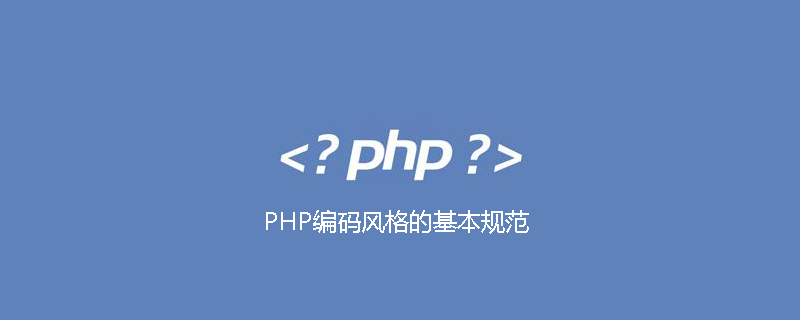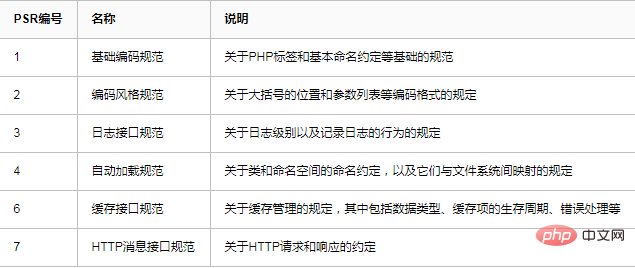Basic specifications of PHP coding style

Due to the flexibility of PHP, many people do not pay attention to a good code specification when writing code, making the already flexible PHP code look messy. In fact, the PSR specification PSR-1 and PSR-2 have defined some specifications in PHP coding. As long as we follow these specifications well, we can write very beautiful and neat code even when using a flexible scripting language. First, let’s take a look at the passed PSR specifications, and then briefly explain some of the specific requirements of the PSR-1 and PSR-2 specifications.
Passed PSR

##PSR-1 Basic Coding Specification
( 1) Opening and closing tagsFirst of all, the PHP code must start with the (2) Side effectsPHP files either declare classes, interfaces, functions, etc., or perform logical operations (such as reading and writing files or sending output to the browser), but they should not do both at the same time Both. (3) NamingThe naming of the class must comply with the camel case naming convention starting with an uppercase letter. In other words, class names should start with a capital letter. There is no requirement to name properties, but they should be consistent. Method names must conform to the camelCase naming convention starting with lowercase. All letters in class constants must be capitalized, and words are separated by underscores. Related recommendations: "PHP Knowledge"
PSR-2 Coding Style Specification
(1) PSR -1 requires PHP code to start with tag, but should end with a blank line. (2) A blank line should be inserted after the namespace declaration, and there should also be a blank line after the use statement block. Don't make multiple use statements in the same line of code. (3) The beginning and end of the classclass keyword, class name, and extends and implements keywords must be on the same line. If a class implements multiple interfaces, the interface names can be on the same line of the class declaration, or they can occupy separate lines. If you choose to place these interface names on multiple lines, the first interface name must be on its own line and not follow the implements keyword. The opening brace ({) of a class should be written on its own line after the function declaration, and the closing brace (}) should also be written on its own line after the class body. That is, the class declaration looks like thisclass EarthGame extends Game implements
Playable,
Savable
{
//类体
}class EarthGame extends Game implements Playble, Savable
{
//类体
}·Single-line declaration
The opening curly brace ({) of the method should be written on its own line after the method name, and the closing curly brace (}) should also be written on the method The body should be on its own line (directly following the method code). Method parameter lists should not start or end with spaces (i.e. they should follow the parentheses surrounding them). For each parameter, there should be a comma after the parameter name (or default value), and a space after the comma. This may sound complicated, as follows:final public static function generateTile(int $diamondCount, bool $polluted = false)
{
//方法体
}·Multi-line declaration
A single-line method declaration is not practical if the method has many parameters. At this point we can split the parameter list so that each parameter (including type, parameter variable, default value, and comma) is on its own indented line. In this case, the closing parenthesis should be placed on the line after the parameter list, aligned with the beginning of the method declaration. The opening curly brace ({) should follow the closing parenthesis on the same line, separated by a space. The method body should start on a new line. Again, this may sound complicated, but the following example should help you understand this rule.public function __construct(
int $size,
string $name,
bool $warparound = false,
bool $aliens = false
) {
//方法体
}$earthGanme = new EarthGame(
5,
'earth',
true,
true
);
$earthGame::generateTile(5, true);流程控制关键字(if、for、while等)后面必须紧跟一个空格。但是,开始圆括号后不能有空格。同样,结束圆括号前不能有空格。因此内容应该紧贴在括号内的。与类和(单行)函数声明相比,流程控制代码的开始花括号应该与结束圆括号在同一行。结束花括号应该自成一行。以下是一个简单的示例。
$title = [];
for ($x = 0; $x < $diamondCount; $x++) {
if ($polluted) {
$title[] = new PollutionDecorator(new DiamondDecorator(new Plains()));
} else {
$title[] = new DiamondDecorator(new Plains());
}
}注意if和for之后的空格。for和if语句与圆括号在同一行,而且它们的结束圆括号后都有一个空格,然后是流程控制体的开始花括号。
The above is the detailed content of Basic specifications of PHP coding style. For more information, please follow other related articles on the PHP Chinese website!

Hot AI Tools

Undresser.AI Undress
AI-powered app for creating realistic nude photos

AI Clothes Remover
Online AI tool for removing clothes from photos.

Undress AI Tool
Undress images for free

Clothoff.io
AI clothes remover

Video Face Swap
Swap faces in any video effortlessly with our completely free AI face swap tool!

Hot Article

Hot Tools

Notepad++7.3.1
Easy-to-use and free code editor

SublimeText3 Chinese version
Chinese version, very easy to use

Zend Studio 13.0.1
Powerful PHP integrated development environment

Dreamweaver CS6
Visual web development tools

SublimeText3 Mac version
God-level code editing software (SublimeText3)

Hot Topics
 1657
1657
 14
14
 1415
1415
 52
52
 1309
1309
 25
25
 1257
1257
 29
29
 1230
1230
 24
24
 PHP 8.4 Installation and Upgrade guide for Ubuntu and Debian
Dec 24, 2024 pm 04:42 PM
PHP 8.4 Installation and Upgrade guide for Ubuntu and Debian
Dec 24, 2024 pm 04:42 PM
PHP 8.4 brings several new features, security improvements, and performance improvements with healthy amounts of feature deprecations and removals. This guide explains how to install PHP 8.4 or upgrade to PHP 8.4 on Ubuntu, Debian, or their derivati
 How do you parse and process HTML/XML in PHP?
Feb 07, 2025 am 11:57 AM
How do you parse and process HTML/XML in PHP?
Feb 07, 2025 am 11:57 AM
This tutorial demonstrates how to efficiently process XML documents using PHP. XML (eXtensible Markup Language) is a versatile text-based markup language designed for both human readability and machine parsing. It's commonly used for data storage an
 Explain JSON Web Tokens (JWT) and their use case in PHP APIs.
Apr 05, 2025 am 12:04 AM
Explain JSON Web Tokens (JWT) and their use case in PHP APIs.
Apr 05, 2025 am 12:04 AM
JWT is an open standard based on JSON, used to securely transmit information between parties, mainly for identity authentication and information exchange. 1. JWT consists of three parts: Header, Payload and Signature. 2. The working principle of JWT includes three steps: generating JWT, verifying JWT and parsing Payload. 3. When using JWT for authentication in PHP, JWT can be generated and verified, and user role and permission information can be included in advanced usage. 4. Common errors include signature verification failure, token expiration, and payload oversized. Debugging skills include using debugging tools and logging. 5. Performance optimization and best practices include using appropriate signature algorithms, setting validity periods reasonably,
 Explain late static binding in PHP (static::).
Apr 03, 2025 am 12:04 AM
Explain late static binding in PHP (static::).
Apr 03, 2025 am 12:04 AM
Static binding (static::) implements late static binding (LSB) in PHP, allowing calling classes to be referenced in static contexts rather than defining classes. 1) The parsing process is performed at runtime, 2) Look up the call class in the inheritance relationship, 3) It may bring performance overhead.
 PHP Program to Count Vowels in a String
Feb 07, 2025 pm 12:12 PM
PHP Program to Count Vowels in a String
Feb 07, 2025 pm 12:12 PM
A string is a sequence of characters, including letters, numbers, and symbols. This tutorial will learn how to calculate the number of vowels in a given string in PHP using different methods. The vowels in English are a, e, i, o, u, and they can be uppercase or lowercase. What is a vowel? Vowels are alphabetic characters that represent a specific pronunciation. There are five vowels in English, including uppercase and lowercase: a, e, i, o, u Example 1 Input: String = "Tutorialspoint" Output: 6 explain The vowels in the string "Tutorialspoint" are u, o, i, a, o, i. There are 6 yuan in total
 What are PHP magic methods (__construct, __destruct, __call, __get, __set, etc.) and provide use cases?
Apr 03, 2025 am 12:03 AM
What are PHP magic methods (__construct, __destruct, __call, __get, __set, etc.) and provide use cases?
Apr 03, 2025 am 12:03 AM
What are the magic methods of PHP? PHP's magic methods include: 1.\_\_construct, used to initialize objects; 2.\_\_destruct, used to clean up resources; 3.\_\_call, handle non-existent method calls; 4.\_\_get, implement dynamic attribute access; 5.\_\_set, implement dynamic attribute settings. These methods are automatically called in certain situations, improving code flexibility and efficiency.
 PHP and Python: Comparing Two Popular Programming Languages
Apr 14, 2025 am 12:13 AM
PHP and Python: Comparing Two Popular Programming Languages
Apr 14, 2025 am 12:13 AM
PHP and Python each have their own advantages, and choose according to project requirements. 1.PHP is suitable for web development, especially for rapid development and maintenance of websites. 2. Python is suitable for data science, machine learning and artificial intelligence, with concise syntax and suitable for beginners.
 PHP: A Key Language for Web Development
Apr 13, 2025 am 12:08 AM
PHP: A Key Language for Web Development
Apr 13, 2025 am 12:08 AM
PHP is a scripting language widely used on the server side, especially suitable for web development. 1.PHP can embed HTML, process HTTP requests and responses, and supports a variety of databases. 2.PHP is used to generate dynamic web content, process form data, access databases, etc., with strong community support and open source resources. 3. PHP is an interpreted language, and the execution process includes lexical analysis, grammatical analysis, compilation and execution. 4.PHP can be combined with MySQL for advanced applications such as user registration systems. 5. When debugging PHP, you can use functions such as error_reporting() and var_dump(). 6. Optimize PHP code to use caching mechanisms, optimize database queries and use built-in functions. 7




